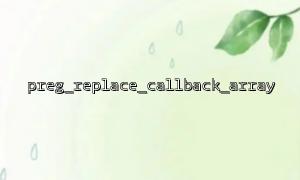In PHP, preg_replace and preg_replace_callback_array are functions for regular replacement operations. They seem similar, but their application scenarios and behaviors vary. This article will take you into the deeper understanding of these two functions, help you to smoothly transition from preg_replace to preg_replace_callback_array , and better grasp their application in actual projects.
preg_replace is the most common regular replacement function in PHP. Its function is to find the part of a string that conforms to a regular pattern and replace it with the given replacement content.
$pattern = '/\d+/'; // Match numbers
$replacement = 'NUMBER';
$string = 'There are 123 apples and 456 oranges.';
$result = preg_replace($pattern, $replacement, $string);
echo $result;
Output:
There are NUMBER apples and NUMBER oranges.
In this example, preg_replace replaces the numeric part in the string with "NUMBER". Its parameters include:
Regular mode $pattern
Replacement content $replacement
Enter the string $string
preg_replace is suitable for simple replacement operations, but if the replacement logic is more complex, or different processing is required for different matches, it may not be flexible enough.
preg_replace_callback_array is a function introduced in PHP 5.5 that provides a more flexible way to handle regular replacement. Its main feature is that it allows you to specify a callback function for each regular expression pattern to perform more complex processing of matching results.
$patterns = [
'/\d+/' => function($matches) {
return 'NUMBER';
},
'/apple/' => function($matches) {
return 'FRUIT';
}
];
$string = 'There are 123 apples and 456 oranges.';
$result = preg_replace_callback_array($patterns, $string);
echo $result;
Output:
There are NUMBER FRUIT and 456 oranges.
In this example, preg_replace_callback_array allows us to specify different callback functions for different regular patterns. In the patterns array, each regular pattern corresponds to a callback function. The callback function receives the match result $matches and returns a replacement value.
This method is more flexible than preg_replace and is suitable for handling complex replacement logic. For example, you can do different processing based on the matching content, without being limited to simple string replacement.
preg_replace is used for simple replacement operations. It's very efficient if you just need to replace the matching part with a fixed string.
preg_replace_callback_array allows you to specify different callback functions for different matching patterns, so it can handle more complex replacement requirements, such as dynamically computing replacement content.
On the performance side, preg_replace will usually be a little faster than preg_replace_callback_array , because the latter requires calling a callback function to handle each match, which adds some overhead.
If the replacement logic is simple, preg_replace should be a more efficient choice.
When using preg_replace_callback_array , you can encapsulate different replacement logics in different callback functions, making the code easier to expand and maintain.
When using preg_replace , if the replacement logic becomes complicated, the readability and maintainability of the code may decrease.
If you are used to using preg_replace but more complex replacement requirements are beginning to appear in your project, you may feel that preg_replace cannot meet the requirements. At this time, you can try to transition to preg_replace_callback_array . For transition steps, please refer to the following points:
Analyze existing code : see where preg_replace is currently used, and analyze which replacement operations require more flexible logic.
Design callback functions : Design one or more callback functions to handle complex replacement logic according to the replacement requirements.
Replace code : Replace preg_replace with preg_replace_callback_array and map the regular pattern with the callback function.
Suppose we have the following code, replacing the number and fruit name with preg_replace :
$pattern = '/(\d+)|(apple)/';
$replacement = function($matches) {
if ($matches[1]) {
return 'NUMBER';
} elseif ($matches[2]) {
return 'FRUIT';
}
};
$string = 'I have 123 apples and 456 oranges.';
$result = preg_replace($pattern, $replacement, $string);
echo $result;
As can be seen, preg_replace combined with callback function implements different replacement requirements. However, such code is not easy to extend. If we were to replace more patterns, the code would become complicated and difficult to manage. At this point, we can use preg_replace_callback_array to make the code more concise:
$patterns = [
'/\d+/' => function($matches) {
return 'NUMBER';
},
'/apple/' => function($matches) {
return 'FRUIT';
},
'/orange/' => function($matches) {
return 'CITRUS';
}
];
$string = 'I have 123 apples and 456 oranges.';
$result = preg_replace_callback_array($patterns, $string);
echo $result;
In this way, each regular pattern corresponds to a callback function, making the code clearer and easier to maintain.
preg_replace and preg_replace_callback_array each have their own advantages and disadvantages. preg_replace is suitable for simple replacements, while preg_replace_callback_array provides greater flexibility for more complex replacement operations. By stepping through preg_replace_callback_array , you can implement more complex regular replacement logic when needed and improve the maintainability of your code. Understanding the difference between the two and choosing the right function according to actual needs will help you handle regular expression-related tasks more efficiently in your PHP project.













